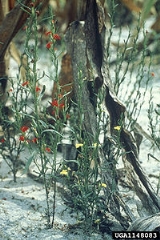
Striga asiatica
Encyclopedia
Asiatic witchweed is a hemiparasitic plant
in the Scrophulariaceae family. It is native to Asia
and sub-Saharan Africa
, but has been introduced into other parts of the world including Australia
and the United States
. Witchweed is a serious agricultural pest as it parasitises important crop species including corn
, rice
, sorghum
, and sugar cane, often causing substantial yield reductions.
In the USA, witchweed was discovered in the Carolinas in 1955. It is considered an invasive
agricultural pest, and a vigorous eradication campaign has reduced the affected area by 99 percent (from 450000 acres (1,821.1 km²) to about 3400 acres (14 km²)).
Biological control can be achieved by growing a Desmodium
(tick-trefoil) undercrop (see push–pull technology. The trefoil can be used as green manure
or animal fodder
after the harvest.
Parasitic plant
A parasitic plant is one that derives some or all of its sustenance from another plant. About 4,100 species in approximately 19 families of flowering plants are known. Parasitic plants have a modified root, the haustorium, that penetrates the host plant and connects to the xylem, phloem, or...
in the Scrophulariaceae family. It is native to Asia
Asia
Asia is the world's largest and most populous continent, located primarily in the eastern and northern hemispheres. It covers 8.7% of the Earth's total surface area and with approximately 3.879 billion people, it hosts 60% of the world's current human population...
and sub-Saharan Africa
Sub-Saharan Africa
Sub-Saharan Africa as a geographical term refers to the area of the African continent which lies south of the Sahara. A political definition of Sub-Saharan Africa, instead, covers all African countries which are fully or partially located south of the Sahara...
, but has been introduced into other parts of the world including Australia
Australia
Australia , officially the Commonwealth of Australia, is a country in the Southern Hemisphere comprising the mainland of the Australian continent, the island of Tasmania, and numerous smaller islands in the Indian and Pacific Oceans. It is the world's sixth-largest country by total area...
and the United States
United States
The United States of America is a federal constitutional republic comprising fifty states and a federal district...
. Witchweed is a serious agricultural pest as it parasitises important crop species including corn
Maize
Maize known in many English-speaking countries as corn or mielie/mealie, is a grain domesticated by indigenous peoples in Mesoamerica in prehistoric times. The leafy stalk produces ears which contain seeds called kernels. Though technically a grain, maize kernels are used in cooking as a vegetable...
, rice
Rice
Rice is the seed of the monocot plants Oryza sativa or Oryza glaberrima . As a cereal grain, it is the most important staple food for a large part of the world's human population, especially in East Asia, Southeast Asia, South Asia, the Middle East, and the West Indies...
, sorghum
Sorghum
Sorghum is a genus of numerous species of grasses, one of which is raised for grain and many of which are used as fodder plants either cultivated or as part of pasture. The plants are cultivated in warmer climates worldwide. Species are native to tropical and subtropical regions of all continents...
, and sugar cane, often causing substantial yield reductions.
In the USA, witchweed was discovered in the Carolinas in 1955. It is considered an invasive
Invasive species
"Invasive species", or invasive exotics, is a nomenclature term and categorization phrase used for flora and fauna, and for specific restoration-preservation processes in native habitats, with several definitions....
agricultural pest, and a vigorous eradication campaign has reduced the affected area by 99 percent (from 450000 acres (1,821.1 km²) to about 3400 acres (14 km²)).
Biological control can be achieved by growing a Desmodium
Desmodium
Desmodium is a genus in the flowering plant family Fabaceae, sometimes called tick-trefoil, tick clover or beggar lice. There are dozens of species and the delimitation of the genus has shifted much over time....
(tick-trefoil) undercrop (see push–pull technology. The trefoil can be used as green manure
Green manure
In agriculture, a green manure is a type of cover crop grown primarily to add nutrients and organic matter to the soil. Typically, a green manure crop is grown for a specific period of time , and then plowed under and incorporated into the soil while green or shortly after flowering...
or animal fodder
Fodder
Fodder or animal feed is any agricultural foodstuff used specifically to feed domesticated livestock such as cattle, goats, sheep, horses, chickens and pigs. Most animal feed is from plants but some is of animal origin...
after the harvest.
Sources
- Invasive.org
- Simberloff, Daniel. 2003. Eradication - preventing invasions at the outset. Weed Science 51:247–253.
- Striga asiatica in Brunken, U., Schmidt, M., Dressler, S., Janssen, T., Thombiano, A. & Zizka, G. 2008. West African plants - A Photo Guide. Forschungsinstitut Senckenberg, Frankfurt/Main.
External Links
- Species Profile- Witchweed (Striga asiatica), National Invasive Species Information Center, United States National Agricultural LibraryUnited States National Agricultural LibraryThe United States National Agricultural Library is one of the world's largest agricultural research libraries, and serves as a National Library of the United States and as the library of the United States Department of Agriculture...
. Lists general information and resources for Witchweed.

